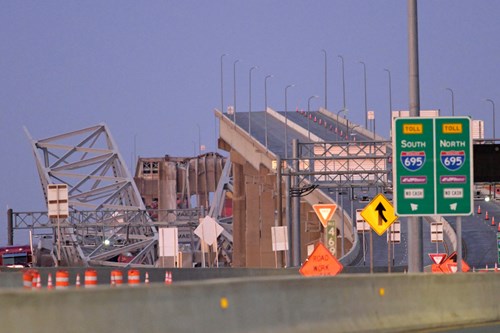All transport through Baltimore's major shipping channel came to a halt last week when a freighter crashed into the Francis Scott Key Bridge and caused it to collapse. But Michael Chajes, a professor of civil and environmental engineering at the University of Delaware, told CBS News that a navigational channel could be achieved before the end of April.
That's good news for one of the nation's busiest ports, one that handled almost 65 tons of cargo in 2023, CBS reported. But the news could be a lot better, Ray Alexander, a retired U.S. Navy commander, said on American Family Radio Monday.
Alexander told show host Jenna Ellis that a failure of leadership from Transportation Sec. Pete Buttgieg will slow the next steps.
"I think Secretary Buttigieg is incompetent and has demonstrated that incompetence during his entire tenure. He should be removed from office – that's my opinion. It's people who are working under him that are making this a somewhat effective operation," Alexander said.

"The challenge is less about resources and more about leadership. What I'm concerned about happening, especially in an election year, is there will be a lot of chest-thumping, a lot of people speaking to the press about their perspective on this problem, and all that's going on with the site operations," he said.
Alexander said the game of politics is an "age-old problem" with emergency response.
"You have a coordinator, a leader of the unified command, and they spend most of their time walking back comments from higher authorities. That's par for the course for this executive administration," he said.
The work will get done, he assured, although most of it will be outsourced by the federal government. And according to Alexander, because the end result will be a functioning channel, most of the public won't understand how much easier the process of reopening could be.
COVID, Houthis underscore importance of shipping
Alexander said jampacked ports and supply chain disruptions because of COVID-19 restrictions and the Red Sea takeover of a relatively small and unsophisticated militant group are examples of the importance of open shipping lanes that are often taken for granted.
"Ports were shut down, and friction was introduced [during the pandemic]," Alexander said. "You're seeing a relatively smaller-scale example of that with Baltimore right now."
Ships are waiting in port, and traffic is building up in the harbor, the Chesapeake Bay area, and further south, he noted.
Another unfortunate example right now is the Houthis off the coast of Yemen.
"I don't want to overstate their capability or understate it either. The Houthis are being supported by Iran and therefore have some seasoned and intelligent leadership, at least advising them. But they are a relatively small group of fighters and insurgents, and they are able to essentially shut down one of the most important shipping lanes in the world," Alexander said.
Federal dollars to pay for outsourcing the work
 Alexander said the national economic impact can be largely absorbed by other ports on the eastern seaboard, starting with Philadelphia. "But the impact to the economy of Baltimore is going to be massive. They're losing millions of dollars a day," he pointed out.
Alexander said the national economic impact can be largely absorbed by other ports on the eastern seaboard, starting with Philadelphia. "But the impact to the economy of Baltimore is going to be massive. They're losing millions of dollars a day," he pointed out.
The Department of Transportation set aside $60 million for Baltimore last week. Buttigieg said on Face The Nation Sunday that more federal money is headed that way.
Although 1,100 Army engineers are headed to Baltimore, most of the federal money will go to non-government employees.
"The funds you're seeing will be almost entirely spent via marine, salvage and support contracts. A small bit of it will be going to Coast Guard operations," Alexander said.
Over the weekend, teams of engineers began the intricate process of cutting and lifting the first section of twisted steel from the collapsed bridge. Seven floating cranes – including a massive one capable of lifting 1,000 tons – 10 tugboats, nine barges, eight salvage vessels and five Coast Guard boats were on site in the water southeast of Baltimore.














